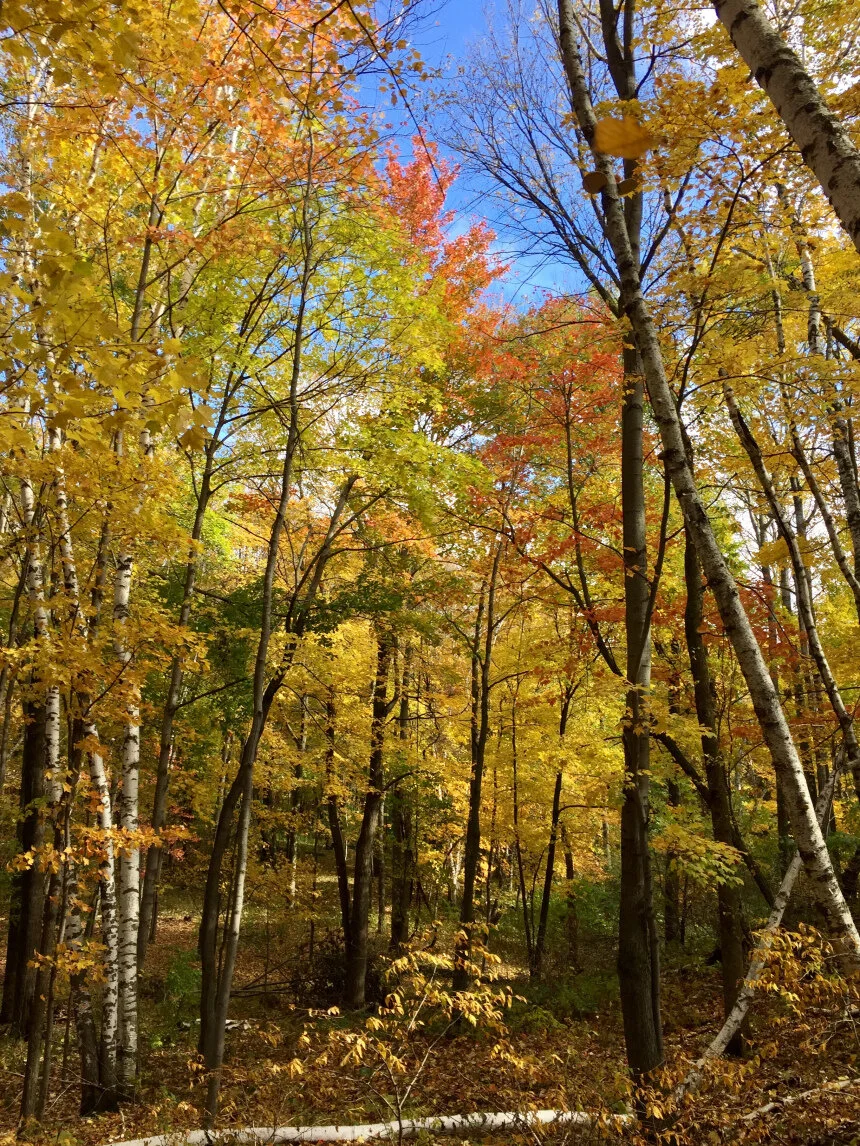Ten years of hard work result in big accomplishments for local water, land, and wildlife
By: Angie Hong - East Metro Water Resource Education Program (EMWREP)
The clock strikes midnight as another page turns over on the calendar of life. Goodbye nameless decade; hello roaring ‘20s! This week many of us are thinking about changes in our lives over the past ten years – children born, loved ones lost, new homes, new jobs, vacations, and special events. In the conservation world, these past ten years have also been marked by big achievements for local water, land and wildlife.
These gorgeous woods are staying healthy, thanks to local conservation efforts.
Water monitoring studies show that more than half of the lakes in Washington County have improving water quality. Some of these lakes have seen incremental changes – Bone Lake in Scandia and Long Lake in Stillwater crept up the charts from C to B grades – while others have made more dramatic transitions. Moody Lake in southern Chisago County and Shields Lake in Forest Lake moved from turbid to clear water states thanks to efforts led by the Comfort Lake – Forest Lake Watershed District. Lynch Lake in May Twp., considered one of the “Top 10 worst lakes” by the Metropolitan Council in 2009, rang in 2019 with a solid grade of C. Lake McKusick in Stillwater was officially removed from Minnesota’s impaired waters list.
Local officials learn about successful efforts to clean up Shields Lake.
In other good news, most of the best lakes in the region maintained their A-grade ratings. Within the Carnelian-Marine-St. Croix watershed, Mays, Clear, Terrapin, East Boot, Square, Big Carnelian, Little Carnelian were successfully protected from degradation. In other parts of the county, Pine Tree Lake (Grant), Jane and Olson (Lake Elmo), Long Lake (Mahtomedi), and Sunset Lake (Hugo) also stayed great.
Local streams are flourishing as well. In Afton, Valley Branch Watershed District partnered with state agencies and local communities to maintain clean water and naturally reproducing trout populations in Valley Creek. In Stillwater, Brown’s Creek Watershed District completed several large projects over the past ten years to lower water temperatures and reduce pollution flowing into Browns Creek. As a result, trout and rainbow darters are once again surviving and reproducing in the stream.
Stillwater high school students sample invertebrates in Browns Creek. Populations of fish and insects are flourishing in the creek thanks to restoration efforts.
In addition, local government partners completed a number of large-scale projects during the past decade to reduce flooding risk, improve water quality, provide better access to nature, and improve wildlife habitat. South Washington Watershed District and Washington County built a bridge over Grey Cloud slough that allowed water to begin flowing freely through a backwater channel of the Mississippi River for the first time in 50 years. The South Washington WD also completed four out of five components in a multi-phase project to connect land-locked southern Woodbury to the Mississippi River, including making major improvements at Cottage Grove Ravine Regional Park.
The Ramsey-Washington Metro Watershed District accomplished a four-year, multi-phase project to capture and filter 67% of the stormwater flowing off of 35 acres of asphalt at the Maplewood Mall (up from just 3% before the project) using tree trenches, raingardens, and a 5,700-gallon cistern. In addition, the Minnesota DNR created a new 6-mile paved trail across central Washington County (Brown’s Creek); Washington Conservation District and Washington County installed a tunnel under Highway 4 to provide safe passage for turtles and other wildlife; and nine local communities incorporated Minimal Impact Design Standards (MIDS) into their city ordinances to ensure better stormwater management during development and redevelopment projects.
The turtle tunnel in northern Washington County helps to protect the endangered Blanding’s turtle and other wildlife.
Best of all, during the past ten years, thousands of local citizens stepped up to protect water, woods and wildlife. The Washington Conservation District sold 211,675 trees to local residents to plant in backyards, farms and woodlands. Landowners completed 1571 urban and agricultural conservation projects with support from cost-share, grant and permit programs. Twenty-seven local farmers got certified through the Minnesota Agricultural Water Quality Certification program. Nine churches, seven homeowner associations, seven schools, and five golf courses installed large-scale conservation projects on their land to reduce stormwater runoff, minimize groundwater pumping, and create better wildlife habitat. Twenty local residents became Master Water Stewards through a partnership with Freshwater Society and thirty were trained as St. Croix Master Watershed Stewards. Last, but not least, volunteers adopted 9979 storm drains across the Twin Cities metro area, including 285 in Washington County since April of 2019.
Stephanie Wang (lower right) and Anna Barker (second from left in pink) are among the many volunteers working to protect water, habitat, and wildlife in Washington County.
As we move into a new decade, I’m inspired by the hard work of our nonprofit and governmental partners and grateful for the overwhelming support of local community members. Cheers to a new decade with clean water, healthy land, and abundant wildlife!




